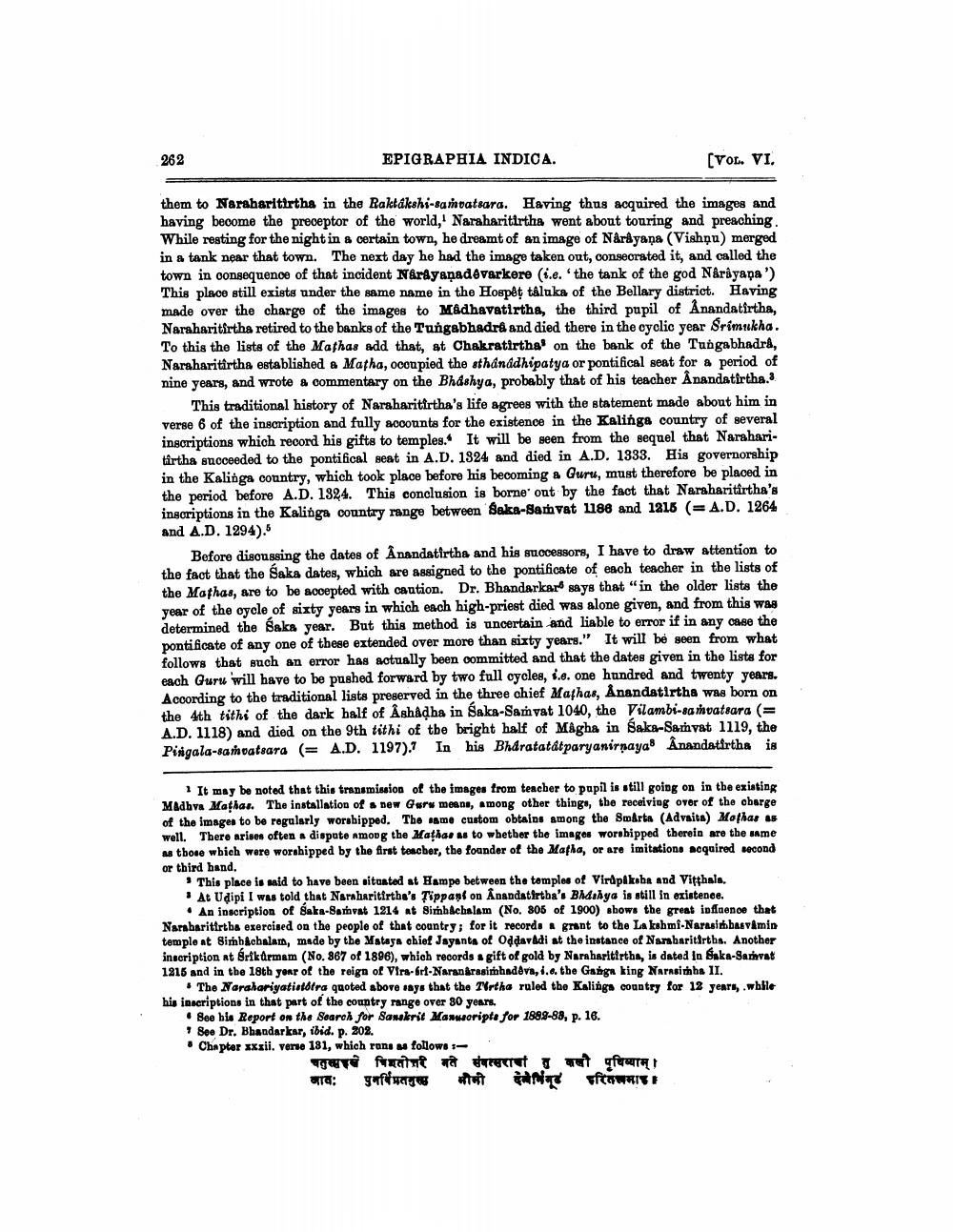________________
262
EPIGRAPHIA INDICA.
(VOL. VI.
them to Naraharitirtha in the Raktákshi-santatsara. Having thus acquired the images and having become the preceptor of the world, Naraharitirtha went about touring and preaching While resting for the night in a certain town, he dreamt of an image of Narayana (Vishņu) merged in a tank near that town. The next day he had the image taken out, consecrated it, and called the town in consequence of that incident Narayanadávarkere (i.e. the tank of the god Náråyapa') This place still exists under the same name in the Hospet tåluka of the Bellary district. Having made over the charge of the images to Madhavatirtha, the third pupil of Anandatirtha, Naraharitirtha retired to the banks of the Tungabhadra and died there in the cyclic year Srimukha. To this the lists of the Mathas add that, at Chakratirtha on the bank of the Tungabhadra, Naraharitirtha established a Matha, occupied the sthanadhipatya or pontifical seat for a period of nine years, and wrote a commentary on the Bhashya, probably that of his teacher Anandatirtha.
This traditional history of Naraharitirtha's life agrees with the statement made about him in verse 6 of the inscription and fully accounts for the existence in the Kalinga country of several inscriptions which record his gifts to temples. It will be seen from the sequel that Naraharitartha suoceeded to the pontifical seat in A.D. 1324 and died in A.D. 1333. His governorship in the Kalinga country, which took place before his becoming a Guru, must therefore be placed in the period before A.D. 1324. This conclusion is borne' ont by the fact that Naraharitîrtha's inscriptions in the Kalinga country range between Saka-samvat 1188 and 1216 (= A.D. 1264 and A.D. 1294).5
Before discussing the dates of Anandatirtha and his successors, I have to draw attention to the fact that the Saka dates, which are assigned to the pontificate of each teacher in the lists of the Mathas, are to be accepted with caution. Dr. Bhandarkart says that "in the older lists the year of the oycle of sixty years in which each high-priest died was alone given, and from this was determined the Saks year. But this method is uncertain and liable to error if in any case the pontificate of any one of these extended over more than sixty years." It will be seen from what follows that such an error has actually been committed and that the dates given in the lists for each Guru will have to be pushed forward by two full cycles, 1.e. one hundred and twenty years. According to the traditional lists preserved in the three chief Mathas, Ånandatirtha was born on the 4th tithi of the dark half of ÅshAdha in Saka-Samyat 1040, the Vilambi-samvatsara (= A.D. 1118) and died on the 9th tithi of the bright half of Magha in Saka-Sanyat 1119, the Pingala-samvatsara (= A.D. 1197). In his Bhdratatatparyanirnaya Anandatirtha is
It may be noted that this transmission of the images from teacher to pupil is still going on in the existing Madhva Mathas. The installation of new Garw mesne, among other things, the receiving over of the aberge of the images to be regularly worshipped. The same custom obtains among the Smarta (Advaita) Molhas as well. There arises often a dispute among the Mathai as to whether the images worshipped therein are the same A those wbich were worshipped by the first tencber, the founder of the Mafha, or are imitations acquired second or third hand.
* This place is said to have been situated at Hampe between the temples of Virdplksba and Vitthals. • At Udipi I was told that Narsharitirtha's Tippani on Anandatirtba's Bhahya is still in existence.
• An inscription of Saka-Barvat 1214 at Simbachalam (No. 806 of 1900) shows the great influence that Narabaritirtha exercised on the people of that country; for it records « grant to the Lakshmi-Narasitobasvamin temple at Simhachalam, made by the Mataya chief Jayants of Oddavadi at the instance of Nanabaritirths. Another inscription at Brik Ormam (No. 867 of 1896), which records a gift of gold by Naraharltirths, is dated In Saka-Sarvat 1215 and in the 18th your of the reign of Vira-hrt-Naranarasimhadova, 1.o the Ganga king Narasimha II.
The Narahariyatistótra quoted above says that the Tyrtha ruled the Kalings country for 12 years, .wblle his inscriptions in that part of the country range over 80 years.
• See his Report on the Search for Sanskrit Manuscripta for 1889-88, p. 16.
See Dr. Bhandarkar, ibid. p. 202. • Chapter xxxii. verse 181, which runs as follows:
चतुमचे विनतीजी मते संवत्सरा तु कली पृथिव्याम् । बाव: पुनर्विप्रतमुह मौमी देवढि हरितवमा




